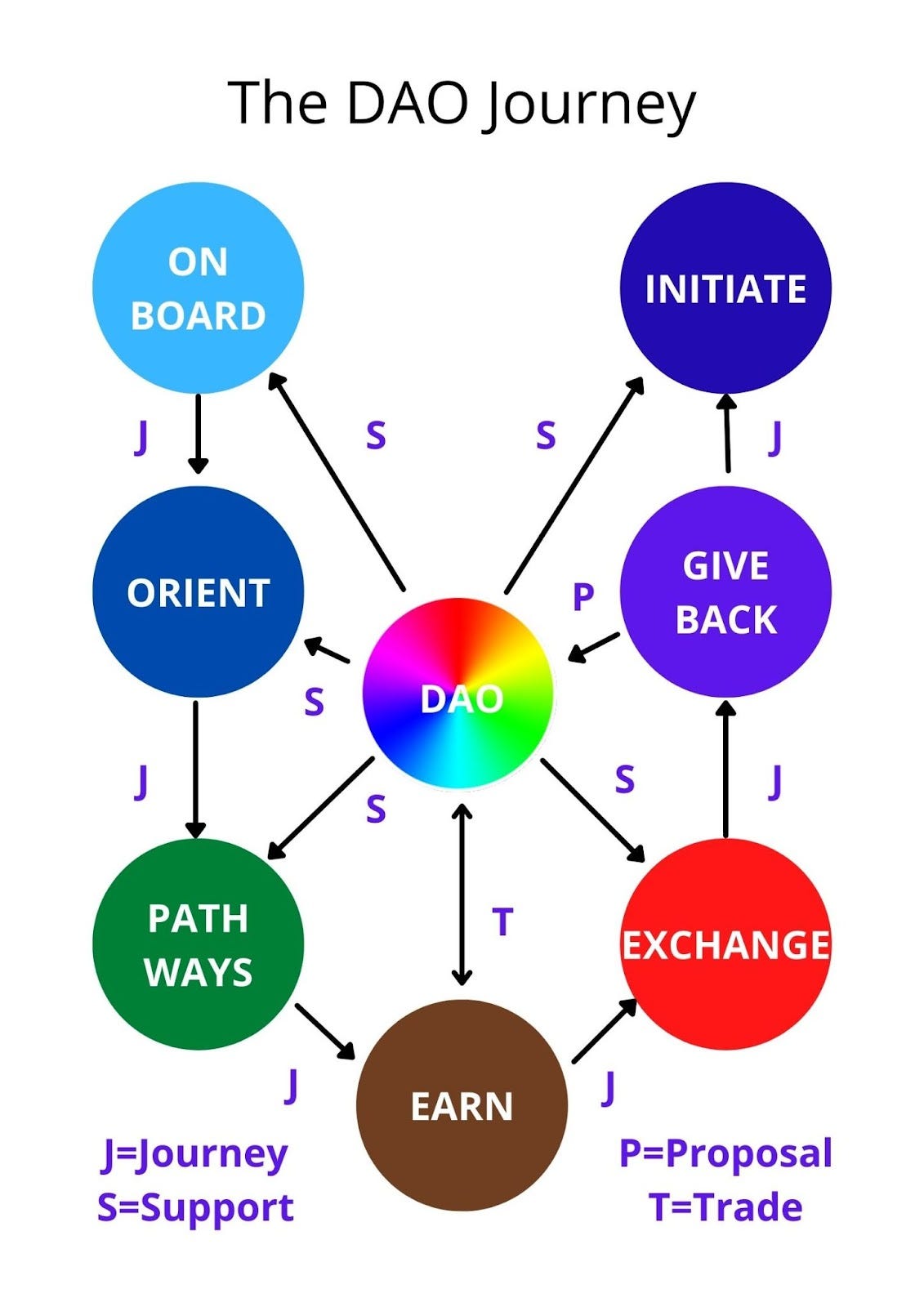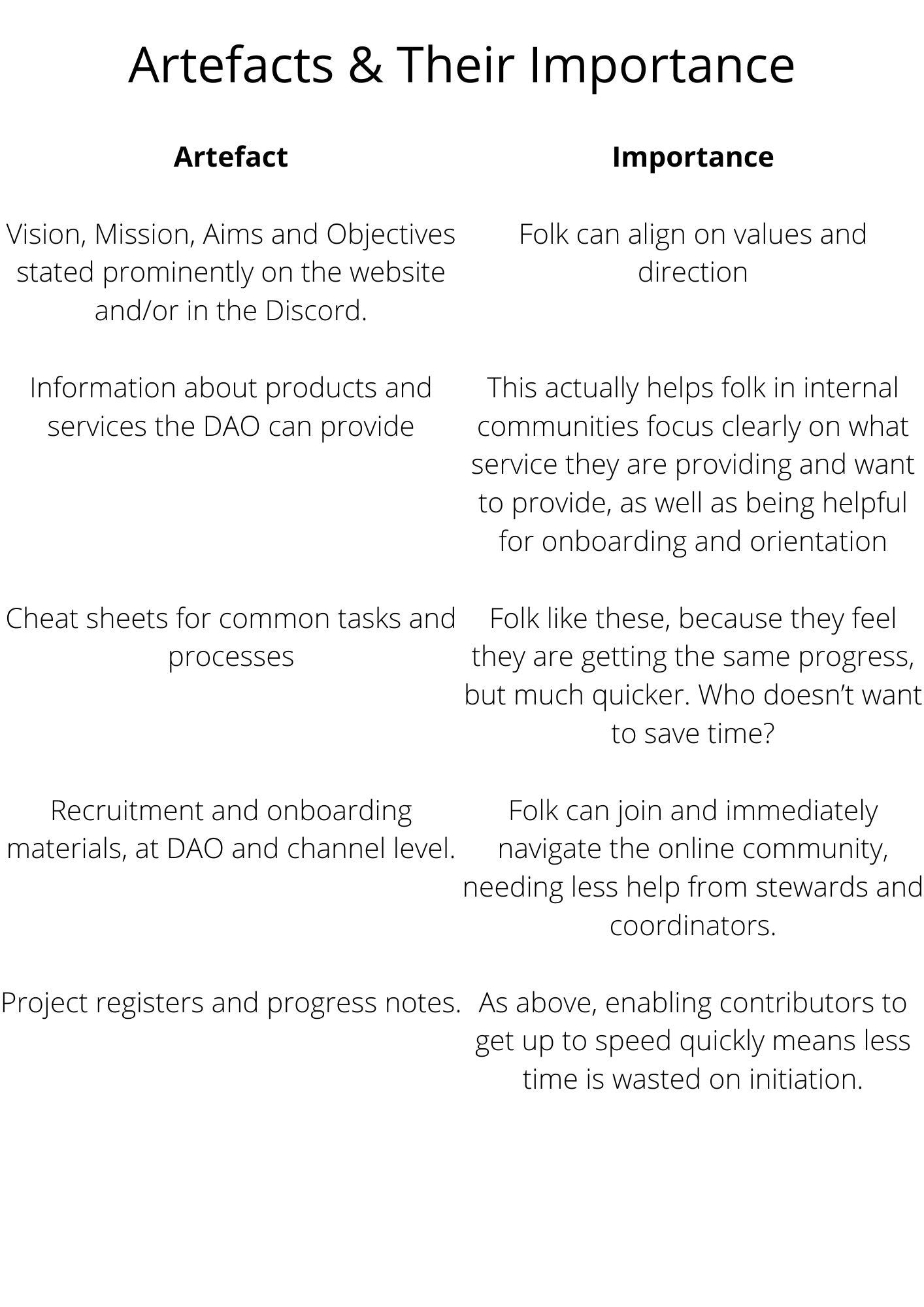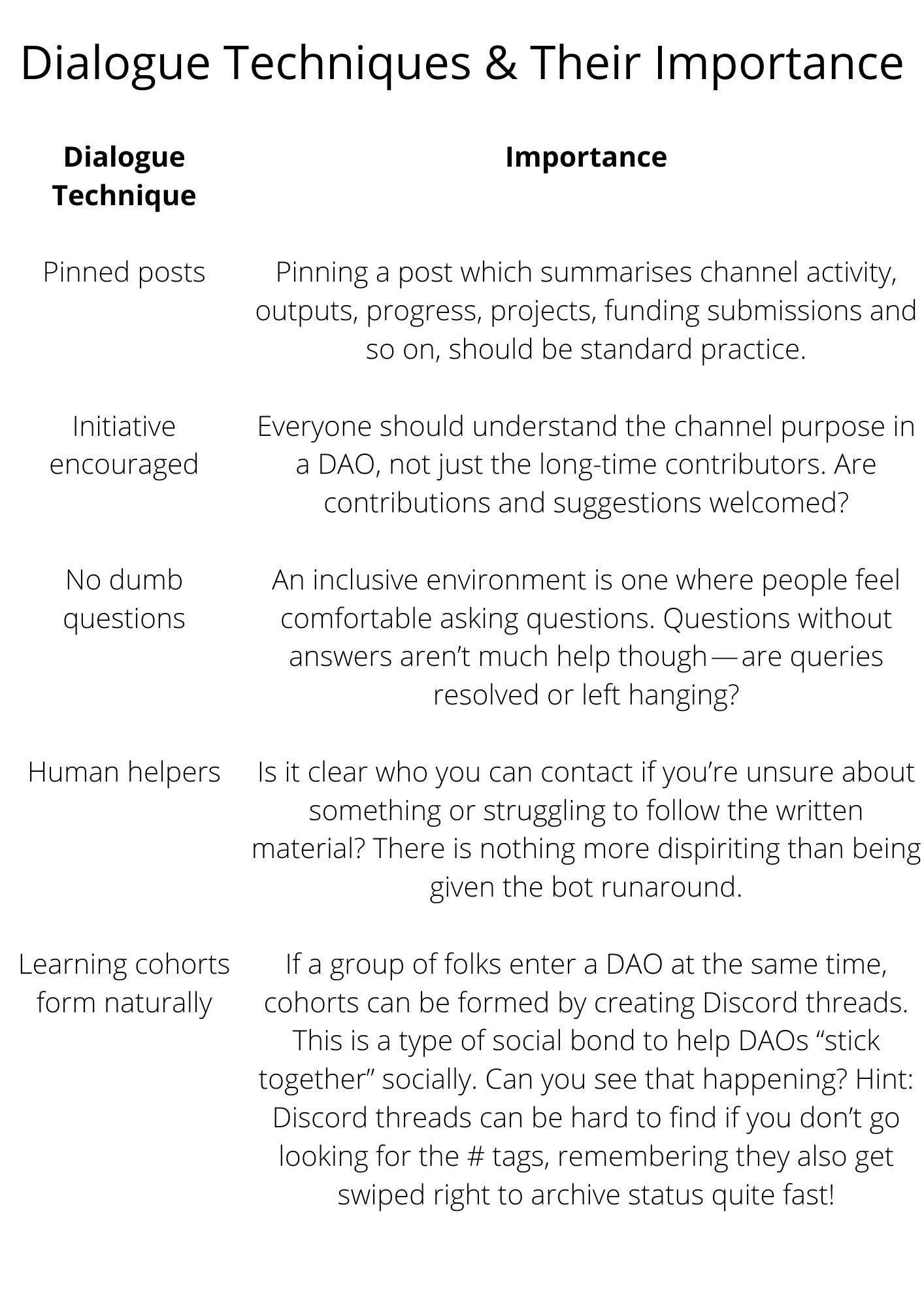What to Focus on and How it Will Retain Contributors
Article by Peter Jones | Edited by links and Trewkat | Cover art by Dippudo
Welcome to Bankless Publishing’s Crypto Basics Series. We’ll be shipping all of our introductory web3 content on Mirror each Monday, enabling users to curate a web3 reference library by minting NFTs on Optimism.
What’s the best job you’ve ever had? Whether you were an employee or the job was one you did as a business owner, chances are that it tops your list because of the experience you had while doing the work. Research into ‘traditional’ employee satisfaction repeatedly shows that there are five key factors at work (so to speak): task enjoyment, an understanding of why the task is important, the people, a culture of feedback, and opportunities for growth. It’s not so different in DAOs; where retaining people who enjoy the work and align with the culture can create a win-win situation for all.
DAOs are a brand new and amazing work environment, and they often allow you to ‘walk’ right in, look around, and decide if you want to stay and make a contribution. Rather than an employer deciding you’re their preferred candidate, you get to decide whether you like that working community. This is some role reversal! But what makes a DAO sticky? What makes it stand out, and what stops you from leaving in favour of another of the hundreds of DAOs out there?
What Makes a DAO Sticky?
First, I should explain what I mean by ‘sticky’ — this is a concept made popular through Malcolm Gladwell’s book, The Tipping Point, which refers to the factors which help make an idea memorable or interesting. In this article, I’m using it to describe the aspects of DAOs that make someone want to ‘stick around’, i.e. stay on as a contributor.
When we join a DAO, many of which have a wonderful open-door policy, we are typically seeking a community with activity, inclusivity, and recognition. We hope to find fellow contributors who are community-minded, who want us all to step up to the plate together, and who jointly foster and value contributions being made. We look for folk who understand our common need for help at times, and who are willing to offer mutual support.
DAOs need talent, like every employer, so they certainly need to worry about stickiness. Folk can walk in, but out again just as easily — open doors can also be revolving doors.
Web3 is giving us significant opportunities for better working conditions and recognition methods, for more inclusive and effective talent attraction and retention. As contributors, what should we be looking for, as DAO communities continue to mature?
This article identifies stickiness factors in four sections:
-
Easy paths to contribution
-
Earning and value exchange
-
Proposal paths that meet community needs
-
DAO impact, sustainability, and growth
1. Easy Paths to Contribution
A DAO thrives on consistency and quality contribution from its members. So how can a DAO make the path to contribution and community membership easy? What learning paths, structures and signposting do folk need to start moving rapidly from onboarding to making contributions?
New Arrivals and Navigating DAO Complexity
A path to contribution without a solid onboarding process is nothing more than a maze; putting out the red carpet for new members is vital to the health of a DAO.
Many DAOs have layers of complexity, different working groups, different skill sets, and different activities. There are multiple highly fluid sub-communities under one roof. The first questions a new arrival usually has are: what is everyone doing, and where might I fit in? Who would I fit in with? Onboarding and orientation are critical success factors. Experienced DAO folk do a lot of context switching, and can change position very rapidly, discussion in Discord or Discourse channels can progress quickly and will often reference previous events or discussions. A new person without a firm grasp on the basics could easily decide that the discussion is impenetrable and leave.

This diagram shows a typical journey in a DAO and the support levels individuals need in a DAO, and some common community transactions.
Individual learning curves do vary, and many folk who are gamers have that explorer gene, and are really happy finding their own way forward. But equally, even gamers have communities who will share hidden moves with friends, and who will team up for certain games. DAOs that ensure people feel welcome are far stickier than those where new people encounter cliques they don’t know how to break into.
Here are two mental checklists with which to measure a DAO’s onboarding chops and assess where improvements could be suggested.
DAO Knowledge Assets
A new contributor’s learning curve can be significantly enhanced by the presence of self-help learning materials or artefacts. Self-learning paths release DAO stewards and coordinators from high-touch work, either in meetings or chat channels.
What learning materials and knowledge assets should we look for in a DAO? Use the following checklist to rate a DAO you might be thinking of joining or are already a member of:

DAO Dialogue
Many DAOs use a platform called Discord for general discussion, and for pointing communities to a variety of separate Web3 resources, including e.g. community governance.
There are a few good habits folks can develop in Discord to help structure and demystify the onboarding journey for new arrivals.
Use this checklist to assess whether your potential DAO is managing discussions effectively:

2. Earning and Value Exchange
A light bulb moment for me was being awarded tokens for bounty work rendered. I could see the token had an exchange rate measured in USD, and suddenly I could understand the exchange of value in a way that previously had felt murky.
In some DAOs, it’s not clear how to earn tokens, and in some cases exchange rates aren’t available or viable. But maybe we still want to do the work anyway, because we think it’s necessary and important. It is a privilege to be able to afford such largesse, but many have much more immediate needs.
Thinking about your own priorities is as equally important to the stickiness question as finding clarity about available opportunities.
A clear understanding of these factors is critical to avoid members’ disappointment, or in some cases outright disputes, as well as the more typical issue of disinterest and lack of engagement.
Bounty platforms are beginning to be far more visible right across the DAO landscape. A DAO that chooses to embrace and test these out is a good bet in terms of the ability to connect contributors with defined tasks and claimable rewards.
It has been posited that a clear tokenomics model is essential for a DAO. Here I defer to Web3 incumbents who have far greater experience than I do right now, but it does seem a given that contributors should be able to find clear guidance on the token ecosystem they plan to step into.
DAOs often also offer membership perks, which could help to make contributors want to stick around. Just like gym access or dental benefits offered by traditional employers, DAOs that are able to provide appealing extras — such as early access to NFT minting or exclusive learning opportunities and social events — are likely to attract and retain people.
3. Proposal Paths That Meet Community Needs
Typically, sticky proposals are submitted by folk who’ve been in and around a DAO long enough to know how it works, and can tune in pretty well to what will help the whole community prosper. Ideally a DAO should encourage and facilitate the development of proposals that are well scoped and have tasks defined in cost terms, so that the community can vote as informed and engaged participants.
Idea Pipelines and Visible Proposals
A sticky DAO will typically contain an easy-to-find listing of previous proposals and why they succeeded or failed. That way, contributors can avoid proposing ideas that the community has already vetoed, or, if new information has come to light, a previous proposal can be resurrected.
The technology platforms for ideation and approval stages will differ, but DAOs that are doing this well usually have clearly defined pathways to community consensus. The DAO’s Discord is the place to raise initial ideas; sometimes a thread is used to contain and concentrate the discussion. Finding threads can be difficult so here is the Discord FAQ on that.
Discourse, Commonwealth, or Snapshot are used for a more formal debate about strategic issues or to vote on proposals. These stages usually only follow once clear support has been established in community chat. A major advantage of having the final, distilled stages of the discussion captured somewhere other than the noise of a Discord is that these can easily be referred back to and serve as the historical record.
Once a proposal is approved, that knowledge management aspect becomes even more important, to ensure the stated outcomes are recorded and analysed.

Proposal Value Metrics / KPIs
The addition of Value Metrics to proposals is another sign that the DAO is serious about defining success for their contributors. This doesn’t mean a Milton Friedman scorched-earth, profit-only focus; instead I’m suggesting a Balanced Scorecard approach, where we can measure planetary impact, community impact, health implications and so on.
It’s likely that some DAOs are further ahead than others on this aspect of proposal formation. While some will simply want to see alignment with community values, others will be looking for stronger reporting mechanisms on proposed actions.
This may all come down to the emphasis you wish to place as an individual, but the DAO that has a clear and measurable proposal system in place is, in my book, pretty sticky.
4. DAO Impact, Sustainability, and Growth
These are big topics in their own right, worthy of further analysis and discussion, so they are relatively brief mentions here.
We will use the following structural analysis here, namely Impact, Sustainability & Growth.
-
Impact: Stephen R Covey in the 7 Habits always says, “Begin with the End in Mind”. Where is an initiative going, and who will it benefit?
-
Sustainability: Who is involved in development and operation, and how will they sustain themselves from the involvement?
-
Growth: If this is successful to this point, should we grow what is happening to benefit more folk? Can we also do that sustainably?
Impact
Overall, the final stickiness we need is a strong focus on DAOs being outward looking. What is the DAO’s value and impact? How do DAOs relate to other DAOs, and how do they relate to Web2 businesses or communities?
Here’s where the open door feature is really useful, because to find out about a new DAO, we can simply join the Discord and start looking around. The community’s focus will be evident from the available channels and the discussions happening therein. Are people there for social reasons, a specific cause, or the development of a product?
The pursuit of a demonstrable impact, even if it’s something like community building, will in turn demonstrate the value proposition for potential contributors.
Sustainability
Learning and development cycles are critical for continuous improvement and the avoidance of damaging mistakes in a DAO. The factors that make a DAO sticky (i.e. sustainable) within the Web3 ecosystem are the same as those which make it attractive to new contributors. In fact, this is a virtuous cycle; a DAO that continually attracts new talent is bound to be doing something right, and in turn has a better chance of success because of the influx of new ideas. On the flip side of the coin, a DAO that is stagnating will be unlikely to attract and retain new contributors.
Growth
We also need to look at DAO size. Dunbar’s number in corporate environments suggests groups of 150 is a maximum size for folk effectively working together, and that efficiencies of scale tail-off after that. It’s possible Dunbar’s number is rather bigger in a Web3 DAO setting; I’ve seen DAOs with tens of thousands of members.
Size versus efficiency is definitely something DAOs need to bear in mind, chaos and cacophony will deafen and turn certain groups of DAO members away. This is an aspect of DAOs that might take a little time to assess, but over a matter of weeks it’s likely that a new contributor will get a good sense of whether the DAO size is helping or hindering the mission.
Stickiness Goes Both Ways
Ultimately, finding a DAO that is a good fit for you might be trial and error, or it might be love at first sight. You can keep in mind the factors covered here, but it will come down to your own circumstances and priorities. One piece of advice I leave you with is that a DAO will usually be as sticky as you make it. The best method, by far, of testing a DAO’s appeal is to get your feet wet. Ask questions, make suggestions, join voice calls, and encourage other contributors.
Tip: Try what I tried. Just join the BanklessDAO Discord server. Find your area of interest and begin to explore!
A version of this article was originally published by Bankless Publishing on August 17, 2022
Author Bio
Peter Jones has been involved in innovation and tech right from the start of a long working career. A skilled, collaborative and successful project manager, but having accidentally fallen out of tech, he found his way back in trying to help connect rural Africans — struggling with very poor power and web access — to more supportive, generative and inclusive crypto communities, a journey full of future opportunity and promise he is loving. You can find him @innov8tor3 on Twitter and in Discord.
Editor Bios
links is a web2 product leader and startup artist seeking inspiration in web3.
Trewkat is an editor and active BanklessDAO Writers Guild member. She’s interested in learning about crypto and NFTs, with a particular focus on how best to communicate this newfound knowledge to others.
Designer Bio
Dippudo started contributing to Bankless DAO after falling down the crypto rabbit hole in the middle of 2021. He subsequently won the Fight Club NFT Competition and is working on numerous other projects within the DAO and The Rug News as a designer. He is now spending time diving deeper into the worlds of economics, computer science, and finance.
BanklessDAO is an education and media engine dedicated to helping individuals achieve financial independence.
Disclaimer: this isn’t investment advice. This article has been written for informational and educational purposes only and it reflects my personal experience and current views, which are subject to change.
Bankless Publishing is always accepting submissions for publication. We’d love to read your work, so please submit your article here!
Other Articles in the Crypto Basics Series
Decentralized Ledger Technology 101 by The Crypto Barista
The 101 on NFTs, A Briefing by Lanz
4 Simple Steps To Join a DAO by Samantha Marin
Towards Better Token Distribution by Paul Hoffman
Cryptocurrency Wallets 101 by ijeblowrider
How To Learn Solidity by oxzh
Ultimate NFT Red Flag Checklist by kalex1138.eth